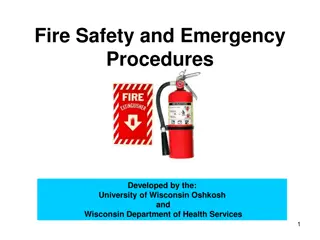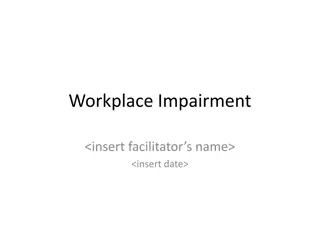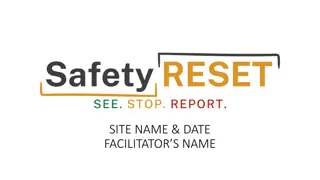Workplace Health and Safety Training and Procedures
Maintaining a safe work environment is crucial. This comprehensive guide covers various aspects of health and safety in the workplace, from specific training programs to reporting procedures for incidents and hazards. Learn about using concern forms, submitting employee incident reports, accessing bulletin boards, taking safety walkabouts, identifying common workplace hazards like chemical safety, and more. Stay informed and proactive to ensure a secure work environment for everyone.
Download Presentation

Please find below an Image/Link to download the presentation.
The content on the website is provided AS IS for your information and personal use only. It may not be sold, licensed, or shared on other websites without obtaining consent from the author. Download presentation by click this link. If you encounter any issues during the download, it is possible that the publisher has removed the file from their server.
E N D
Presentation Transcript
HDSB Specific Health & Safety Training
Reporting an Occupational Health & Safety Concern A Concern Form can be used to report a hazard you believe presents a risk to the health and safety of individuals in your workplace This form can be found by searching concern form on the myHDSB homepage. Once you have completed the form, submit it to your supervisor.
Reporting an Employee Incident or Injury An Employee Incident Report (EIR) must be submitted for any incident that resulted or could have resulted in an injury to a worker. The EIR can be found via the myHDSB homepage under: A-Z Listings> E Find a Form>Human Resources Forms> Health and Safety This form should be completed with your supervisor, and must be signed by your supervisor. Please refer to page 1 of the EIR for instructions on how to complete the form.
The Health & Safety Bulletin Board The Health & Safety bulletin board houses many important documents including: Occupational Health & Safety Admin Procedure (AP) List of current first aiders at your site Violence Prevention in the Workplace AP Respectful Workplaces Free of Discrimination & Harassment AP Copy of the Occupational Health & Safety Act Current Joint Health & Safety Committee members
Walkabout for Safety If you are new to your site, your supervisor will take you on a walkabout for safety. This walkabout is to help you identify key contacts, processes and hazards at your work location.
Chemicals Only use Board provided chemicals. Do not bring chemicals in from home. Always make sure that all chemicals not in their original containers are labelled properly. This includes , for example, spray bottles with water in them and glue in a yogurt container. Be sure to store chemicals properly with their lids secured tightly. Always print off the Safety Data Sheets (SDS)* for any chemicals you will be using. * Material Safety Data Sheets (MSDS) can be used until Dec 1, 2018
Chemicals Contd SDS are located on an external database. The database can be accessed through the myHDSB homepage: Applications> Safety Data Sheets (SDS). Instructions on how to use the SDS database can be found on myHDSB by searching SDS instructions . Have you done your WHMIS training?
Biological Bacteria, virus, fungi Universal precautions consider all blood and body fluids as potentially infected with blood-borne pathogens Wash Yours Hands a "do-it-yourself" vaccine Regular handwashing, particularly before and after certain activities, is one of the best ways to remove germs, avoid getting sick, and prevent the spread of germs to others.
Electrical Only use electrical equipment that has been approved by a certification agency (E.g.. CSA, UL, ULC, ETL, etc.). Extension cords are not designed to be used as permanent wiring and must be plugged directly into a wall outlet. Always unplug extension cords after you are done using them. Power bars must be plugged directly into a wall outlet. Be sure all electrical cords are in good condition. Do not use if the cord is cut, frayed or otherwise damaged. NEVER plug extension cords or power bars together in a chain. If you need a longer cord, purchase a longer power bar that will meet your needs.
Ergonomic Always lift heavy objects by crouching and using your legs. Ensure that your workstation is ergonomically set-up to avoid injury. Ergonomics for Computer User tips are available on hdsbTV. Office workstation ergonomic assessments are available through the Health & Safety Department.
Fire Safety A Fire Safety Binder is located at every school or search for it on myHDSB. What is a combustible? A combustible is anything that is able to catch fire and burn easily. 3ft x 12ft rule for posting combustibles in the hallway (for every 12 feet of combustible (paper) there must be 3 feet of clear wall. Doors offer a 3 foot clearance. Keep combustibles away from heat sources such as heaters. No combustibles on doors, in stairwells or routes of egress. No hanging combustibles from ceilings. No appliances are allowed in classrooms unless they are required for curriculum delivery.
Slips, Trips & Falls Slips, trips and falls are some of the leading causes of compensable injury within HDSB. Always use step stools or step ladders provided at the school. Check that they are in good condition before use. Do not stand on chairs, desks or other furniture. Take care to wear footwear that is appropriate for any task that could be required of you during your work day. Report any spills or debris on floors or walkways to your supervisor.
Workplace Violence & Aggression What is workplace violence? Workplace violence is defined as: the exercise of or the attempt to exercise physical force by a person against a worker, in a workplace, that causes or could cause physical injury to the worker, a statement or behaviour that it is reasonable for a worker to interpret as a threat to exercise physical force against the worker, in a workplace, that could cause physical injury to the worker Because of the nature of our business, there is a risk of violence in the workplace. Parents, students, visitors, co-workers, etc. could all potentially bring violence into our buildings.
Workplace Violence & Aggression Cont d Be sure to complete the Violence Prevention training as well as Working Alone AP training. Managing Violent & Aggressive Behaviour of Students with Special Needs is a good AP to review if you work with or in close proximity to students with special needs.
Personal Protective Equipment (PPE) Any PPE that is provided to you by the HDSB must be worn for its intended use and maintained in good condition. This includes: safety goggles, gloves, Kevlar sleeves, etc.
Hazard Specific Training As part of your role at the HDSB you may be required to attend hazard specific training to ensure you are trained to perform a task safely. E.g. Fall arrest, lock out/tag out, first aid, scissor lift, curriculum specific safety training, etc.
Safety Resources Board Safety Manuals: Fire Safety Manual Health & Safety Resource Binder Asbestos register (in schools built before 1985) Curriculum Safety Guidelines: Art Science Technology Physical Education
Questions ? Talk to your supervisor if you have any specific questions about your workplace. Or contact the Health & Safety Department.






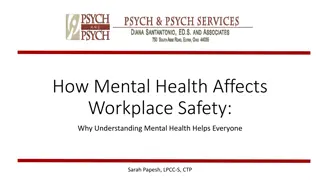
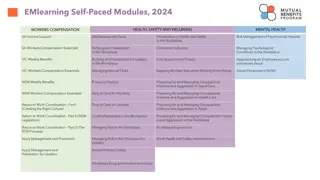
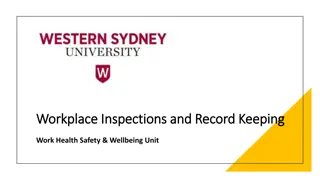



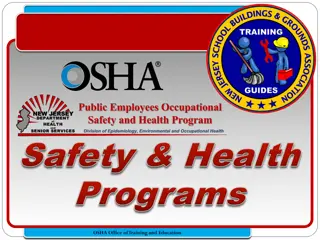
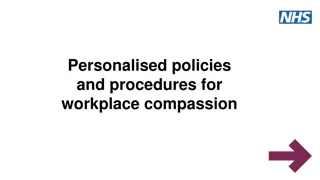


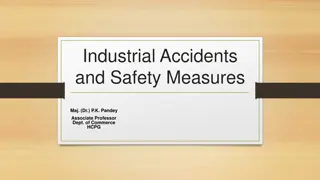

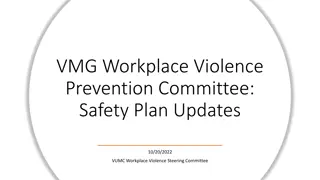
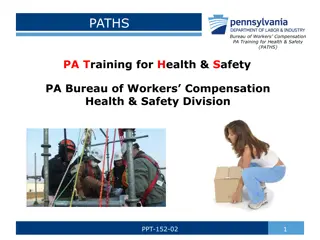
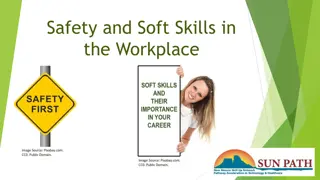

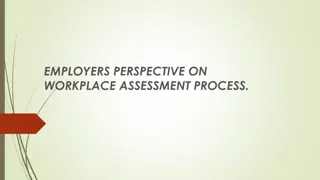



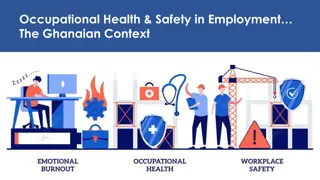
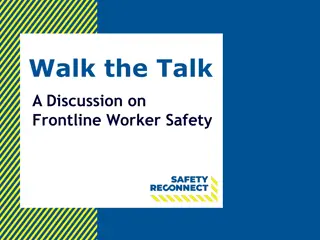

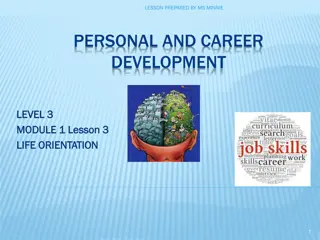


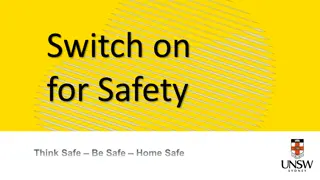
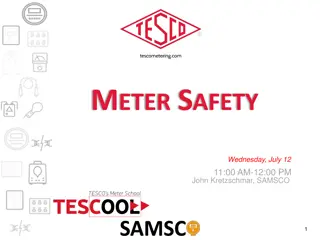

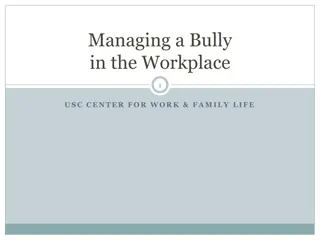


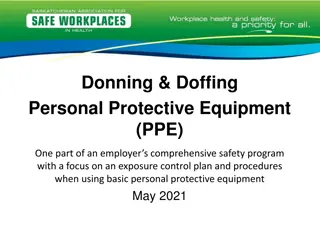
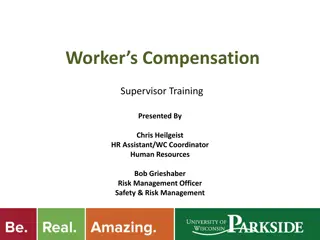

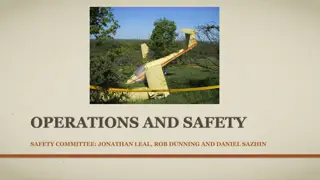
![Workplace Violence Prevention Plan in [District]: Definitions, Elements, and Implementation](/thumb/117038/workplace-violence-prevention-plan-in-district-definitions-elements-and-implementation.jpg)


